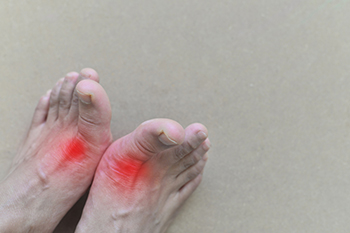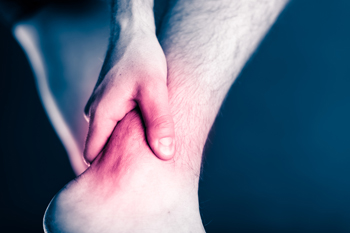Items filtered by date: June 2023
How Did I Get Gout?

Gout is a type of arthritis and can be uncomfortable. Gout generally affects the joints in the big toe and can cause debilitating pain. Additional symptoms can consist of swelling, redness, and the affected joints can feel hot. A condition that is known as hyperuricemia is defined as having excess uric acid in the body. This may happen from genetic reasons, or from eating foods that have high levels of purines. These types of foods can include shellfish, red meat, and drinks that are made with large amounts of sugar. Gout is more prevalent among males, and it may affect women who are postmenopausal. It can also develop in people who are diabetic, have congestive heart failure, or have high blood pressure. It is helpful to implement prevention strategies that can consist of eating healthy foods, engaging in a gentle exercise routine, and drinking plenty of water daily. If you have had one or more gout attacks, it is strongly suggested that you are under the care of a podiatrist who can help you to manage it and offer additional prevention techniques.
Gout is a painful condition that can be treated. If you are seeking treatment, contact Nrup Tolat, DPM from Atlanta Total Foot & Ankle Care. Our doctor will treat your foot and ankle needs.
What Is Gout?
Gout is a form of arthritis that is characterized by sudden, severe attacks of pain, redness, and tenderness in the joints. The condition usually affects the joint at the base of the big toe. A gout attack can occur at any random time, such as the middle of the night while you are asleep.
Symptoms
- Intense Joint Pain - Usually around the large joint of your big toe, and it most severe within the first four to twelve hours
- Lingering Discomfort - Joint discomfort may last from a few days to a few weeks
- Inflammation and Redness -Affected joints may become swollen, tender, warm and red
- Limited Range of Motion - May experience a decrease in joint mobility
Risk Factors
- Genetics - If family members have gout, you’re more likely to have it
- Medications - Diuretic medications can raise uric acid levels
- Gender/Age - Gout is more common in men until the age of 60. It is believed that estrogen protects women until that point
- Diet - Eating red meat and shellfish increases your risk
- Alcohol - Having more than two alcoholic drinks per day increases your risk
- Obesity - Obese people are at a higher risk for gout
Prior to visiting your podiatrist to receive treatment for gout, there are a few things you should do beforehand. If you have gout you should write down your symptoms--including when they started and how often you experience them, important medical information you may have, and any questions you may have. Writing down these three things will help your podiatrist in assessing your specific situation so that he or she may provide the best route of treatment for you.
If you have any questions, please feel free to contact our offices located in Woodstock and Atlanta, GA . We offer the newest diagnostic and treatment technologies for all your foot care needs.
Reminder: When Was the Last Time...?
Causes and Remedies for Heel Spurs

Heel spurs, which are often associated with plantar fasciitis, can become painful. They occur when calcium builds up on the bottom of the heel bone. These outgrowths, or spurs, may be caused by foot muscle strains, stretching of the plantar fascia, and a tearing of the membrane that covers the heel bone. Heel spurs are common in athletes who perform sports that require a great deal of running and jumping. Other causes can include gait issues that put extra pressure on the heels, running on hard surfaces, and poorly fitting shoes with inadequate arch support. Excess weight and obesity may also contribute to the formation of heel spurs. In some cases, a person may not experience any symptoms from heel spurs. But others may feel intermittent or chronic pain, especially after running or long periods of exercise. Stretching exercises, pain medication, and shoe inserts are helpful treatment options. For more information on methods to deal with heel spurs, it is suggested that you make an appointment with a podiatrist.
Heel spurs can be incredibly painful and sometimes may make you unable to participate in physical activities. To get medical care for your heel spurs, contact Nrup Tolat, DPM from Atlanta Total Foot & Ankle Care. Our doctor will do everything possible to treat your condition.
Heels Spurs
Heel spurs are formed by calcium deposits on the back of the foot where the heel is. This can also be caused by small fragments of bone breaking off one section of the foot, attaching onto the back of the foot. Heel spurs can also be bone growth on the back of the foot and may grow in the direction of the arch of the foot.
Older individuals usually suffer from heel spurs and pain sometimes intensifies with age. One of the main condition's spurs are related to is plantar fasciitis.
Pain
The pain associated with spurs is often because of weight placed on the feet. When someone is walking, their entire weight is concentrated on the feet. Bone spurs then have the tendency to affect other bones and tissues around the foot. As the pain continues, the feet will become tender and sensitive over time.
Treatments
There are many ways to treat heel spurs. If one is suffering from heel spurs in conjunction with pain, there are several methods for healing. Medication, surgery, and herbal care are some options.
If you have any questions feel free to contact our offices located in Woodstock and Atlanta, GA . We offer the latest in diagnostic and treatment technology to meet your needs.
How to Deal With a Stiff Ankle

A stiff and painful ankle is common after an ankle injury, such as an ankle sprain, fracture, or Achilles tendon tear. Stretching, mobilizing, and re-training can increase the mobility and functionality of the ankle. Patients are often put in a cast after an ankle injury, and while the immobilization helps with healing, it also creates swelling and inflammation. Dorsiflexion is important while walking and running, and occurs when the foot comes up towards the shin. This is one of the most frequent and limiting ranges of motion lost after an ankle problem. A quick, short-term option to relieve some of the stiffness is to wear shoes that have a heel or heel wedge. Longer term, it is suggested that you be under the care of a podiatrist who can help you with proper exercises and other relief options for stiff ankles.
Ankle pain can be caused by a number of problems and may be potentially serious. If you have ankle pain, consult with Nrup Tolat, DPM from Atlanta Total Foot & Ankle Care. Our doctor will assess your condition and provide you with quality foot and ankle treatment.
Ankle pain is any condition that causes pain in the ankle. Due to the fact that the ankle consists of tendons, muscles, bones, and ligaments, ankle pain can come from a number of different conditions.
Causes
The most common causes of ankle pain include:
- Types of arthritis (rheumatoid, osteoarthritis, and gout)
- Ankle sprains
- Broken ankles
- Achilles tendinitis
- Achilles tendon rupture
- Stress fractures
- Bursitis
- Tarsal tunnel syndrome
- Plantar fasciitis
Symptoms
Symptoms of ankle injury vary based upon the condition. Pain may include general pain and discomfort, swelling, aching, redness, bruising, burning or stabbing sensations, and/or loss of sensation.
Diagnosis
Due to the wide variety of potential causes of ankle pain, podiatrists will utilize a number of different methods to properly diagnose ankle pain. This can include asking for personal and family medical histories and of any recent injuries. Further diagnosis may include sensation tests, a physical examination, and potentially x-rays or other imaging tests.
Treatment
Just as the range of causes varies widely, so do treatments. Some more common treatments are rest, ice packs, keeping pressure off the foot, orthotics and braces, medication for inflammation and pain, and surgery.
If you have any questions, please feel free to contact our offices located in Woodstock and Atlanta, GA . We offer the newest diagnostic and treatment technologies for all your foot care needs.
Blunt Force Can Cause a Broken Toe

Blunt trauma is generally the cause of a broken toe. This can happen if a heavy object drops on it, or if it is stubbed into a piece of furniture. If the toe is mildly broken, it may be classified as a stress or hairline fracture, and the buddy taping method is generally successful in treating this foot condition. This is done by taping the broken toe to the toe next to it, which can provide the necessary stability as the healing process occurs. If the toe is severely fractured, it may have a bone protruding from it, or it may have shattered from direct force. A diagnosis is performed that can confirm and determine the severity of the broken toe. This is done by having an X-ray taken and is followed by beginning the correct treatment method. The symptoms that are often accompanied by this ailment can include swelling, immediate bruising, and severe pain. If you have fractured your toe, it is strongly suggested that you confer with a podiatrist who can provide treatment.
Broken toes may cause a lot of pain and should be treated as soon as possible. If you have any concerns about your feet, contact Nrup Tolat, DPM from Atlanta Total Foot & Ankle Care. Our doctor will treat your foot and ankle needs.
What Is a Broken Toe?
A broken toe occurs when one or more of the toe bones of the foot are broken after an injury. Injuries such as stubbing your toe or dropping a heavy object on it may cause a toe fracture.
Symptoms of a Broken Toe
- Swelling
- Pain (with/without wearing shoes)
- Stiffness
- Nail Injury
Although the injured toe should be monitored daily, it is especially important to have a podiatrist look at your toe if you have severe symptoms. Some of these symptoms include worsening or new pain that is not relieved with medication, sores, redness, or open wounds near the toe.
If you have any questions, please feel free to contact our offices located in Woodstock and Atlanta, GA . We offer the newest diagnostic and treatment technologies for all your foot care needs.

